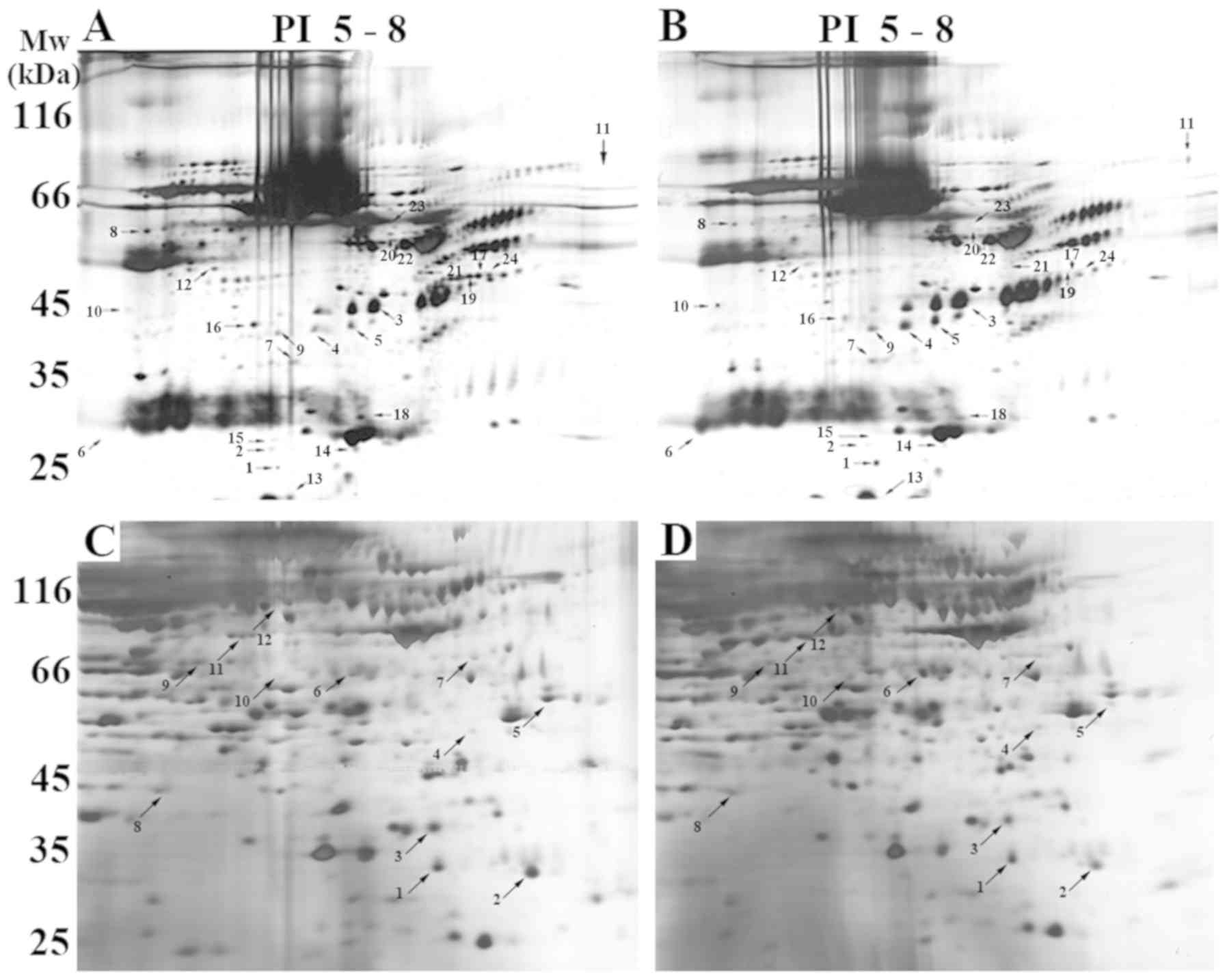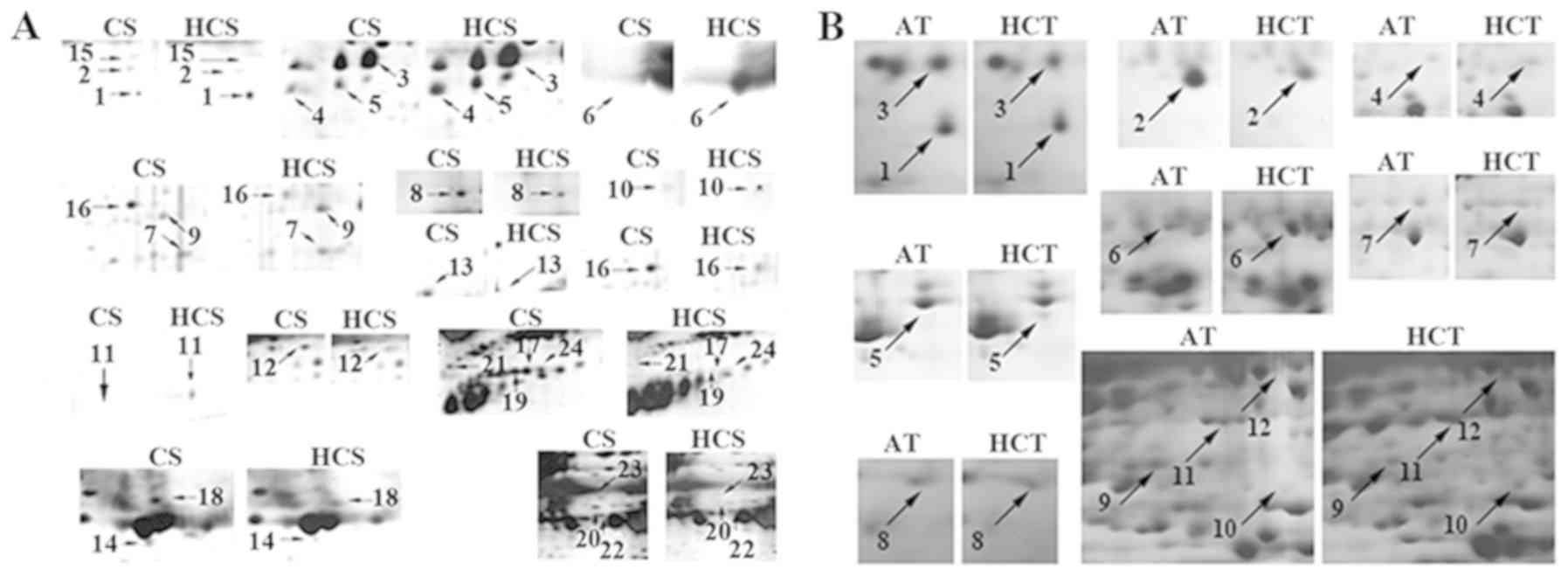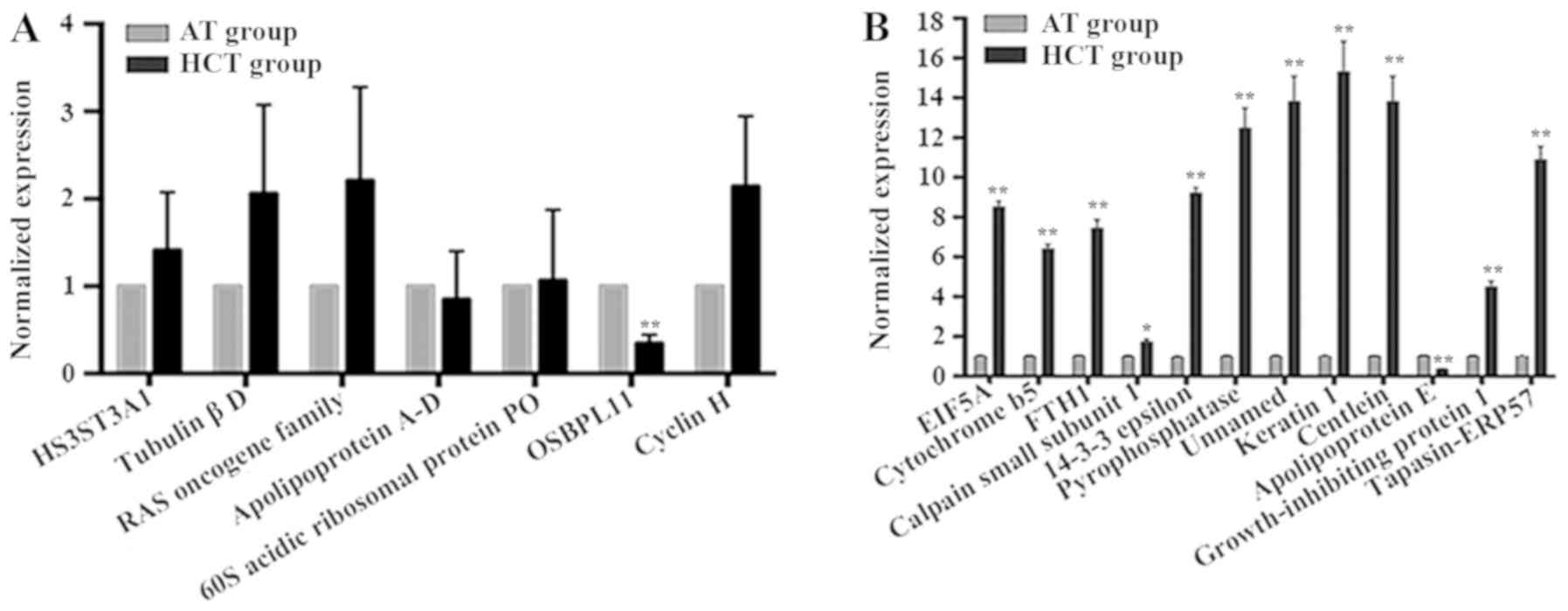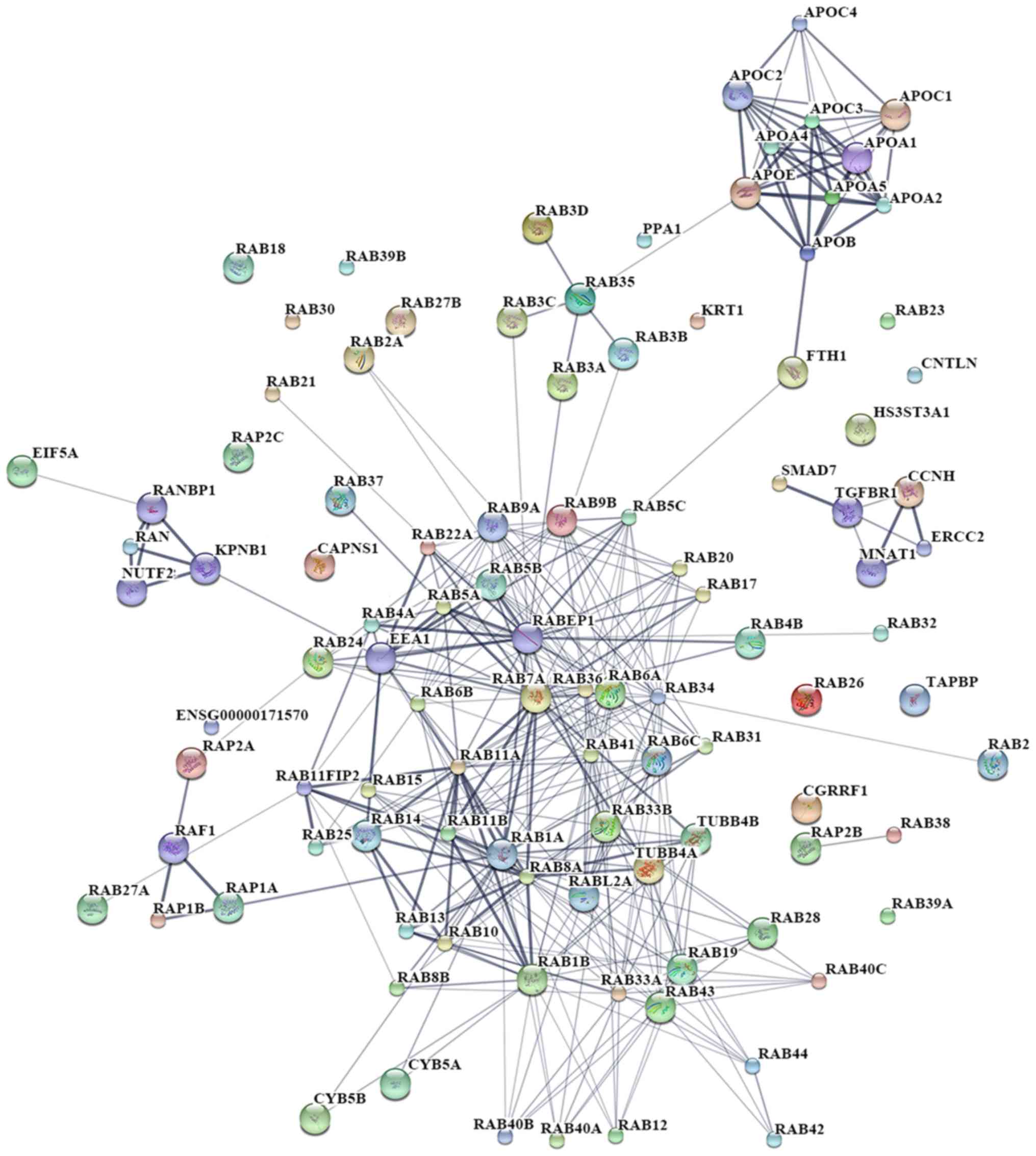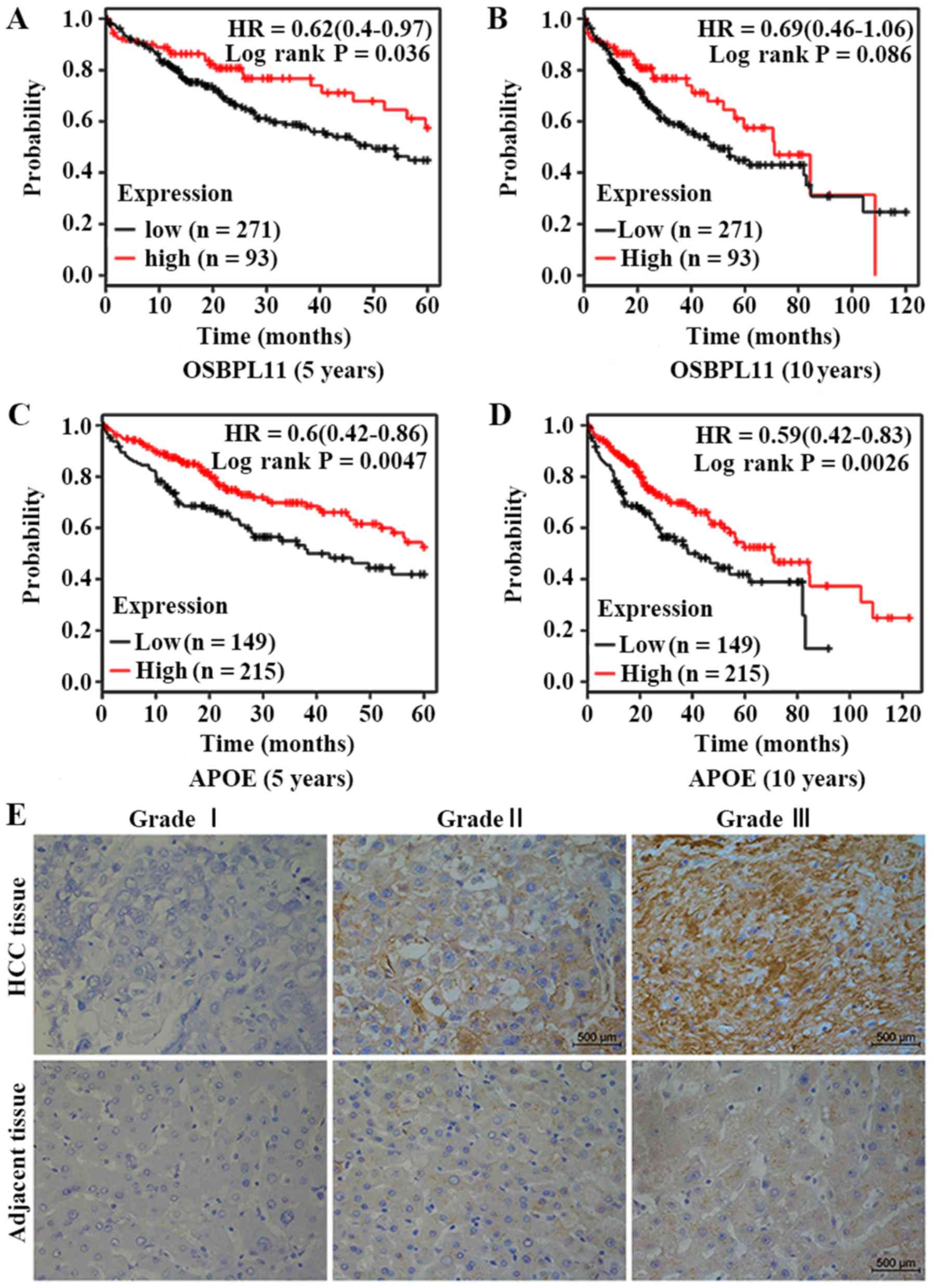|
1
|
Li S, Yang F and Ren X: Immunotherapy for
hepatocellular carcinoma. Drug Discov Ther. 9:363–371. 2015.
View Article : Google Scholar : PubMed/NCBI
|
|
2
|
McGlynn KA, Petrick JL and London WT:
Global epidemiology of hepatocellular carcinoma: An emphasis on
demographic and regional variability. Clin Liver Dis. 19:223–238.
2015. View Article : Google Scholar : PubMed/NCBI
|
|
3
|
Torre LA, Bray F, Siegel R, Ferlay J,
Lortet-Tieulent J and Jemal A: Global cancer statistics, 2012. CA
Cancer J Clin. 65:87–108. 2015. View Article : Google Scholar : PubMed/NCBI
|
|
4
|
Han L, Lv Y, Guo H, Ruan Z and Nan K:
Implications of biomarkers in human hepatocellular carcinoma
pathogenesis and therapy. World J Gastroenterol. 20:10249–10261.
2014. View Article : Google Scholar : PubMed/NCBI
|
|
5
|
Ray S, Patel SK, Kumar V, Damahe J and
Srivastava S: Differential expression of serum/plasma proteins in
various infectious diseases: Specific or nonspecific signatures.
Proteomics Clin Appl. 8:53–72. 2014. View Article : Google Scholar : PubMed/NCBI
|
|
6
|
Chromy BA, Gonzales AD, Perkins J, Choi
MW, Corzett MH, Chang BC, Corzett CH and McCutchen-Maloney SL:
Proteomic analysis of human serum by two-dimensional differential
gel electrophoresis after depletion of high-abundant proteins. J
Proteome Res. 3:1120–1127. 2014. View Article : Google Scholar
|
|
7
|
Sano S, Tagami S, Hashimoto Y,
Yoshizawa-Kumagaye K, Tsunemi M, Okochi M and Tomonaga T: Absolute
quantitation of low abundance plasma APL1β peptides at sub-fmol/mL
Level by SRM/MRM without immunoaffinity enrichment. J Proteome Res.
13:1012–1020. 2014. View Article : Google Scholar : PubMed/NCBI
|
|
8
|
Xu S, Liu P, Lu X, Zhang J, Huang L, Hua
W, He D and Ouyang J: A highly sensitive ‘turn-on’ fluorescent
sensor for the detection of human serum proteins based on the size
exclusion of the polyacrylamide gel. Electrophoresis. 35:546–553.
2014. View Article : Google Scholar : PubMed/NCBI
|
|
9
|
Luo LZ, Jin HW and Huang HQ:
Transferrin-cisplatin specifically deliver cisplatin to HepG2 cells
in vitro and enhance cisplatin cytotoxicity. J Proteomics.
77:237–250. 2012. View Article : Google Scholar : PubMed/NCBI
|
|
10
|
Livak KJ and Schmittgen TD: Analysis of
relative gene expression data using real-time quantitative PCR and
the 2(-Delta Delta C(T)) method. Methods. 25:402–408. 2001.
View Article : Google Scholar : PubMed/NCBI
|
|
11
|
Liu W, Liu B, Cai Q, Li J, Chen X and Zhu
Z: Proteomic identification of serum biomarkers for gastric cancer
using multi-dimensional liquid chromatography and 2D differential
gel electrophoresis. Clin Chim Acta. 413:1098–1106. 2012.
View Article : Google Scholar : PubMed/NCBI
|
|
12
|
Qin S, Ferdinand AS, Richie JP, O'Leary
MP, Mok SC and Liu BC: Chromatofocusing fractionation and
two-dimensional difference gel electrophoresis for low abundance
serum proteins. Proteomics. 5:3183–3192. 2005. View Article : Google Scholar : PubMed/NCBI
|
|
13
|
Chen YY, Lin SY, Yeh YY, Hsiao HH, Wu CY,
Chen ST and Wang AH: A modified protein precipitation procedure for
efficient removal of albumin from serum. Electrophoresis.
26:2117–2127. 2005. View Article : Google Scholar : PubMed/NCBI
|
|
14
|
Amraoui F, Hassani Lahsinoui H, Boussata
S, Keijser R, Veenboer GJ, Middeldorp S, van der Post JA,
Ris-Stalpers C, Afink GB and van den Born BJ: Placental expression
of heparan sulfate 3-O-sulfotransferase-3A1 in normotensive and
pre-eclamptic pregnancies. Placenta. 36:1218–1224. 2015. View Article : Google Scholar : PubMed/NCBI
|
|
15
|
Gajewski MM, Alisaraie L and Tuszynski JA:
Peloruside, laulimalide, and noscapine interactions with
beta-tubulin. Pharm Res. 29:2985–2993. 2012. View Article : Google Scholar : PubMed/NCBI
|
|
16
|
Hall RE, Horsfall DJ, Stahl J,
Vivekanandan S, Ricciardelli C, Stapleton AM, Scardino PT, Neufing
P and Tilley WD: Apolipoprotein-D: A novel cellular marker for
HGPIN and prostate cancer. Prostate. 58:103–108. 2004. View Article : Google Scholar : PubMed/NCBI
|
|
17
|
Lau KS and Haigis KM: Non-redundancy
within the RAS oncogene family: Insights into mutational
disparities in cancer. Mol Cells. 28:315–320. 2009. View Article : Google Scholar : PubMed/NCBI
|
|
18
|
Chang TW, Chen CC, Chen KY, Su JH, Chang
JH and Chang MC: Ribosomal phosphoprotein P0 interacts with GCIP
and overexpression of P0 is associated with cellular proliferation
in breast and liver carcinoma cells. Oncogene. 27:332–338. 2008.
View Article : Google Scholar : PubMed/NCBI
|
|
19
|
Weber-Boyvat M, Zhong W, Yan D and
Olkkonen VM: Oxysterol-binding proteins: Functions in cell
regulation beyond lipid metabolism. Biochem Pharmacol. 86:89–95.
2013. View Article : Google Scholar : PubMed/NCBI
|
|
20
|
Olkkonen VM and Levine TP: Oxysterol
binding proteins: In more than one place at one time? Biochem Cell
Biol. 82:87–98. 2004. View
Article : Google Scholar : PubMed/NCBI
|
|
21
|
Olkkonen VM: OSBP-related protein family
in lipid transport over membrane contact sites. Lipid Insights. 8
(Suppl 1):S1–S9. 2015.
|
|
22
|
Olkkonen VM and Li S: Oxysterol-binding
proteins: Sterol and phosphoinositide sensors coordinating
transport, signaling and metabolism. Prog Lipid Res. 52:529–538.
2013. View Article : Google Scholar : PubMed/NCBI
|
|
23
|
Bondi J, Husdal A, Bukholm G, Nesland JM,
Bakka A and Bukholm IR: Expression and gene amplification of
primary (A, B1, D1, D3, and E) and secondary (C and H) cyclins in
colon adenocarcinomas and correlation with patient outcome. J Clin
Pathol. 58:509–514. 2005. View Article : Google Scholar : PubMed/NCBI
|
|
24
|
Caraglia M, Park MH, Wolff EC, Marra M and
Abbruzzese A: eIF5A isoforms and cancer: Two brothers for two
functions? Amino Acids. 44:103–109. 2013. View Article : Google Scholar : PubMed/NCBI
|
|
25
|
Mathews MB and Hershey JW: The translation
factor eIF5A and human cancer. Biochim Biophys Acta. 1849:836–844.
2015. View Article : Google Scholar : PubMed/NCBI
|
|
26
|
Stiborová M, Indra R, Frei E, Kopečková K,
Schmeiser HH, Eckschlager T, Adam V, Heger Z, Arlt VM and Martínek
V: Cytochrome b5 plays a dual role in the reaction cycle of
cytochrome P450 3A4 during oxidation of the anticancer drug
ellipticine. Monatshefte Fur Chemie. 148:1983–1991. 2017.
View Article : Google Scholar : PubMed/NCBI
|
|
27
|
Henderson CJ, McLaughlin LA, Finn RD,
Ronseaux S, Kapelyukh Y and Wolf CR: A role for cytochrome b5 in
the in vivo disposition of anticancer and cytochrome P450 probe
drugs in mice. Drug Metab Dispos. 42:70–77. 2014. View Article : Google Scholar : PubMed/NCBI
|
|
28
|
Chekhun SV, Lukyanova NY, Shvets YV,
Burlaka AP and Buchinska LG: Significance of ferritin expression in
formation of malignant phenotype of human breast cancer cells. Exp
Oncol. 36:179–183. 2014.PubMed/NCBI
|
|
29
|
Jiang XP and Elliott RL: Decreased iron in
cancer cells and their microenvironment improves cytolysis of
breast cancer cells by natural killer cells. Anticancer Res.
37:2297–2305. 2007. View Article : Google Scholar
|
|
30
|
Dai Z, Zhou SL, Zhou ZJ, Bai DS, Xu XY, Fu
XT, Chen Q, Zhao YM, Zhu K, Yu L, et al: Capn4 contributes to
tumour growth and metastasis of hepatocellular carcinoma by
activation of the FAK-Src signalling pathways. J Pathol.
234:316–328. 2014. View Article : Google Scholar : PubMed/NCBI
|
|
31
|
Leal MF, Calcagno DQ, Demachki S,
Assumpcao PP, Chammas R, Burbano RR and Smith Mde A: Clinical
implication of 14-3-3 epsilon expression in gastric cancer. World J
Gastroenterol. 18:1531–1537. 2012. View Article : Google Scholar : PubMed/NCBI
|
|
32
|
Yang Y, Cai J, Yin J, Wang D, Bai Z, Zhang
J, Wang K, Yu G and Zhang Z: Inorganic pyrophosphatase (PPA1) is a
negative prognostic marker for human gastric cancer. Int J Clin Exp
Pathol. 8:12482–12490. 2015.PubMed/NCBI
|
|
33
|
Tang S, Huang W, Zhong M, Yin L, Jiang H,
Hou S, Gan P and Yuan Y: Identification Keratin 1 as a
cDDP-resistant protein in nasopharyngeal carcinoma cell lines. J
Proteomics. 75:2352–2360. 2012. View Article : Google Scholar : PubMed/NCBI
|
|
34
|
Jing Z, Yin H, Wang P, Gao J and Yuan L:
Centlein, a novel microtubule-associated protein stabilizing
microtubules and involved in neurite formation. Biochem Biophys Res
Commun. 472:360–365. 2016. View Article : Google Scholar : PubMed/NCBI
|
|
35
|
Su WP, Chen YT, Lai WW, Lin CC, Yan JJ and
Su WC: Apolipoprotein E expression promotes lung adenocarcinoma
proliferation and migration and as a potential survival marker in
lung cancer. Lung Cancer. 71:28–33. 2011. View Article : Google Scholar : PubMed/NCBI
|
|
36
|
Hulpke S, Baldauf C and Tampe R: Molecular
architecture of the MHC I peptide-loading complex: One tapasin
molecule is essential and sufficient for antigen processing. FASEB
J. 26:5071–5080. 2012. View Article : Google Scholar : PubMed/NCBI
|















